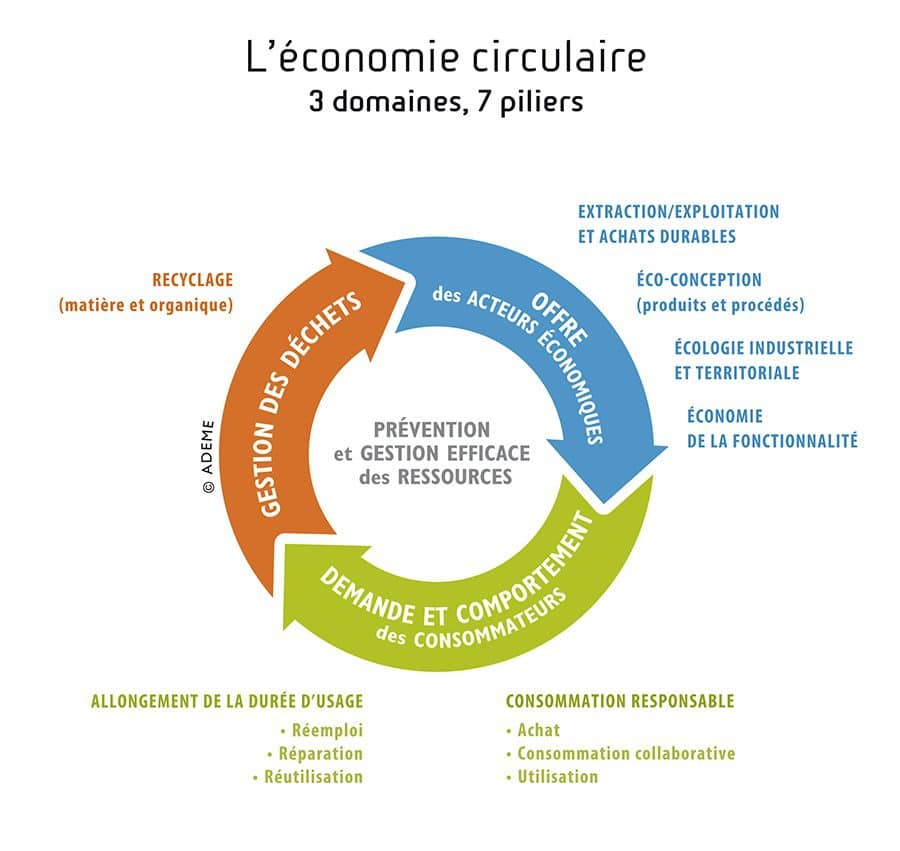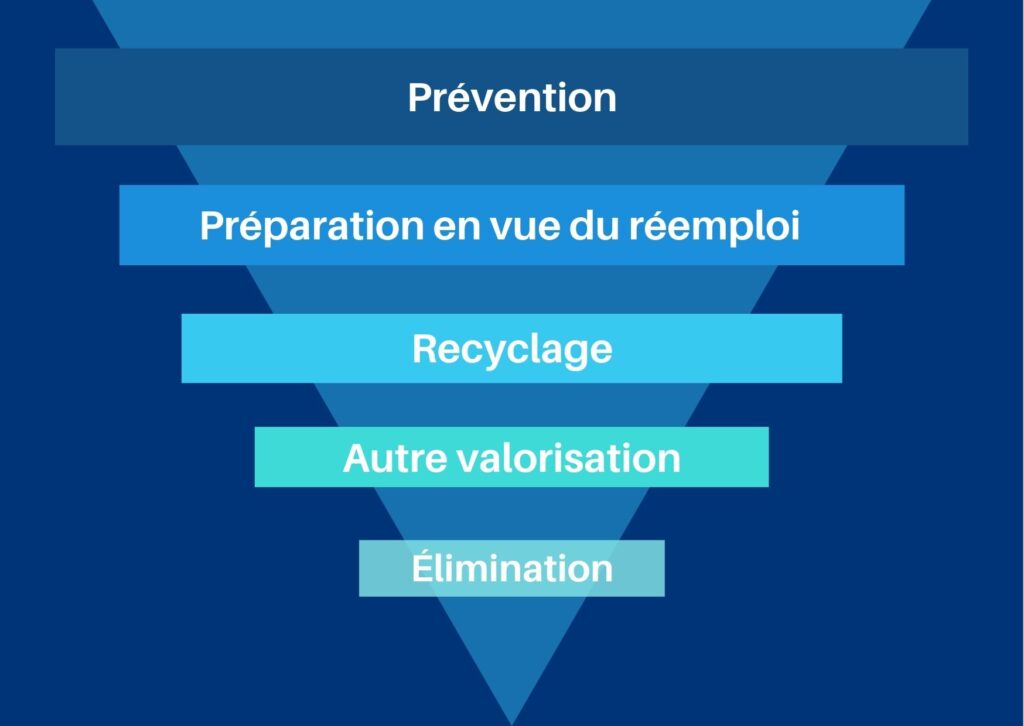Corporate social responsibility (CSR) is a thing of the past, long live the circular economy! That's what politicians, newspaper headlines and the advertisements that accompany our daily lives seem to be telling us. But what if the two concepts were just two sides of the same coin that every company is trying to win in order to remain competitive and meet society's expectations? Adopting a circular economy approach is a winning strategy for businesses, including SMEs. Catherine Viale, consultant and trainer, takes a closer look.

"Extract, manufacture, consume, throw away" sums up the dominant linear economic model. Its multiple negative impacts on the environment and health are now indisputable. Hardly anyone questions its causal link to climate change and biodiversity loss any more.
At present, certain resources that are vital to economic recovery are in short supply. These include wood, building materials, paper, aluminium, vinyl, wheat and semi-conductors. This shortage highlights the rigidity of supply chains and the fragmentation of value chains. Design, extraction, manufacturing and services are separated in different countries, which are themselves often far from the places of consumption. The ecological and economic challenges have therefore converged, leading to a consensus that the circular economy must be the cornerstone of a new social project, at least at European level.
But what is the circular economy?
It is a "an economic model whose objective is to produce goods and services in a sustainable manner".. How ? "By limiting the consumption and wastage of resources (raw materials, water, energy) and the production of waste. This is the definition given by the Ministry of Ecological Transition. And it is with this in mind that companies need to get their act together.
The seven pillars of the circular economy
When we talk about the circular economy, we tend to equate it with the recycling economy and energy efficiency efforts. Although encouraging, these two fields of action are not enough to resolve the equation between sobriety and value creation. This is why the French Environment and Energy Management Agency (ADEME) has defined the principles of the circular economy as follows seven pillars. Closely linked, they are also based on collaboration between the various players in the value chain.

So any project to move towards a circular economy requires us to rethink every stage involved in producing a good and delivering it to the customer. In other words, from design to end use and even beyond. This very often means developing the skills of employees through training initiatives.
Some examples of training courses:
| Skills to acquire or develop : | Training: |
|---|---|
| Ecodesign | Ecodesign of digital services |
| Responsible purchasing | Reconciling purchasing performance and CSR issues Responsible IT purchasing |
| Waste management | Reconciling waste prevention and management with a view to the circular economy Managing business waste in compliance with French regulations |
| Regulations | Implementing a corporate environmental policy Environmental law for non-specialists |
| Project management | The fundamentals of project management Project management, advanced |
| Innovation | Working with suppliers to innovate |
| Communication and marketing | CSR communication: enhancing your company's image Sustainable and responsible marketing |
How can we take concrete action?
But from what angle should you start thinking and define your priorities?
Many companies working in this field are focusing on recyclability (25 %) and extending the life of the products they manufacture (34 %). And they are doing quite well, according to a study by the French National Institute for the Circular Economy (INEC) and the OPEO consultancy (April 2021).
Optimising waste management
A company that wants to get its foot in the door of the circular economy is well advised to explore different solutions for optimising its waste management. To do this, it can rely on the preferred waste treatment hierarchy advocated by the Environment Code (see below).
The preferred waste treatment hierarchy

The challenge ? Involving everyone in the company in the search for "economically acceptable" organisational and technical means of achieving a level of management n-1 for all waste. The idea is to proceed step by step towards reducing waste at source. After all, it's a well-known fact that "the best waste is the waste we don't produce", not least because it costs nothing.
Calculating the true cost of waste
The MFCA (Material Flow Cost Accounting) method defined by ISO 14051: 2011 can be used to calculate the full cost of waste. It quickly reveals that the tip of the financial iceberg is not where you think it is. Choices in terms of design, raw material purchasing and transport logistics have at least as much impact as manufacturing and sorting operations on the quantities of waste generated. UltimatelyThese choices often weigh far more heavily in the balance than the bill from the disposal service providers.
Extending the life of products
Another way of reducing your ecological footprint and your costs is to divert end-of-life products from the status of waste. This status is not only synonymous with a loss of value, but also highly restrictive from a regulatory point of view. To achieve this, the company needs to broaden the consultation of its suppliers and customers to include other players likely to see its waste as a source of value. This can be done either directly or through organisations such as consular chambers, business clubs or economic development agencies. The key idea is to create a network with a view to regional industrial ecology. So we've come full circle!
The circular economy and SMEs: real benefits
Implementing a circular economy project can seem like a relatively heavy investment for a small business. Yet there are very real benefits, such as better cost control and increased competitiveness.
Conquering new markets
Committing to the circular economy means anticipating changes in standards and regulations, rather than accepting them. It also means taking the lead in innovation and becoming a forerunner in a system that is destined to evolve. Or even conquering new markets.
One of the most striking examples is the success of shopping bags, water bottles, mugs and other everyday objects, which are gradually replacing single-use plastic packaging and crockery. And this is happening under pressure from regulations and public opinion.
Reputation and attractiveness
In turn, going green in its practices and offering improves the company's reputation and attractiveness. Firstly, with younger generations of consumers who are keen to consume responsibly. And with employees who want to give meaning to their professional activity.
A medium-term strategic vision
For decision-makers, committing to this approach implies having a medium-term strategic vision to detach themselves from the immediate constraints of their market segment. It also requires a willingness to anchor their business in the local area, favouring short supply chains and creating jobs that cannot be relocated.
Partnerships
To be effective, the circular economy cannot be the result of isolated initiatives. On the contrary, it is based on cooperation between different sectors via inter-economic partnerships, which are at the root of new business models. A good example of this is the explosion in bicycle hire and repair services over the last ten years, provided by associations and craftsmen as well as major sports brands.
In conclusion, optimising waste management is only one aspect of the circular economy. However, it is this approach that is the most practical in terms of bringing about a change in behaviour. In fact, it allows all the business lines to be involved, along with the environment and quality departments, in a holistic analysis of the company's processes. This includes buyers, design offices, operators, maintenance, logisticians, sales staff, etc.
Meeting the need for resilience Faced with finite resources, it is often necessary to rethink the company's business model. Of course, overhauling the organisation, technologies and know-how entails considerable costs. But 85 % of companies that have taken the plunge see it as a real opportunity for their competitiveness and the development of new markets (INEC and OPEO study).
As part of the recovery plan, €350 million has been earmarked to support the circular economy. Support measures financed by ADEME are aimed at SMEs, very small businesses and social economy organisations.
It's the perfect time to get started!


